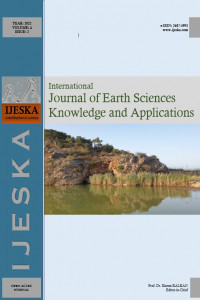Groundwater Potential Evaluation of Federal Polytechnic Ado–Ekiti Using GRRT–Index
Groundwater Potential Evaluation of Federal Polytechnic Ado–Ekiti Using GRRT–Index
Groundwater, Iso-resistivity, Isopach Resistivity, Geo-electric, Groundwater Potential Map,
___
- Adeyemo, I.A., Omosuyi, G.O., Adelusi, A.O., 2017. Geoelectric soundings for delineation of saline water intrusion into aquifers in part of eastern Dahomey basin, Nigeria. Journal of Geoscience and Environment Protection 5 (3), 213-232.
- Ajah, N.J. Zanders, C.C. Okeke, A.O., Kalu, Q., 2019. Evaluation of Groundwater Potential of Owerri West and Environs, Southeastern Nigeria Using Resistivity Method International Journal of Engineering Science 8 (6), 31-43.
- Anomohanran, O., 2013. Geophysical Investigation of Groundwater Potential in Ukelegbe, Nigeria. Journal of Applied Sciences 13 (1), 119-125. https://doi.org/10.3923/jas.2013.119.125.
- Ayobami, S.L., Aanuoluwa, A., Olafisoye, R., Oladejo, O.P., 2012. The groundwater potential evaluation at industrial estate Ogbomoso, Southwestern Nigeria Ocena potenciala podtalnice na industrijskem območju Ogbomoso v jugozahodni Nigeriji. Materials and Geoenvironment 59 (4), 363-390.
- Bala, A.E., Ike E.C., 2001. The aquifer of the crystalline basement rocks in Gusau Area, North-Western Nigeria. Journal of Mining Geology 37 (2), 177-184.
- Chachadi, A.G., João, P.L.F., 2005. Assessing aquifer vulnerability to seawater intrusion using GALDIT method: Part 2 -GALDIT Indicators Description: The fourth inter-celtic colloquium on Hydrology and Management of Water Resources. Guimaraes, Portugal, July 11-14, 2005.
- Jones, M.J., 1985. The weathered zone aquifers of the basement complex areas of Africa. Quarterly Journal of Engineering Geology 18, 35-46.
- Telford, W.M., Geldart, L.P., Sherrif, R.E., 1990. Applied Geophysics. Cambridge University Press, United Kingdom.
- Tolche, A.D., 2021. Groundwater potential mapping using geospatial techniques: a case study of Dhungeta-Ramis sub-basin, Ethiopia, Geology, Ecology, and Landscapes 5 (1), 65-80. https://doi.org/10.1080/24749508.2020.1728882.
- Başlangıç: 2019
- Yayıncı: Ekrem KALKAN
Raphael Oaikhena OYANYAN, Azikboro Kokobakemi OLOGUN
Explaining the Death of Mammoths in Siberia and Dinosaurs in Alaska
Raphael Oaikhena OYANYAN, Modestus Chijioke OHAEGBULEM, Chioma Elizabeth NWAİMO
Maridhadhi PATIENCE, Kodzwa Jefline JENNIFER, Lloyd Shorai Pisa PISA
Sedimentlogical Study of Chack Hydropower Reservoir, Wardak, Afghanistan
Hafizullah RASOULI, Ashok VASEASHTA, Mohammad Hamid HAMDARD
Omasan Godwin AKPERI, Sikiru SALAMI
Response of Climate Change Impact on Streamflow in Sululta Catchment, Abay Basin, Ethiopia
Groundwater Potential Evaluation of Federal Polytechnic Ado–Ekiti Using GRRT–Index
Isaac Ayodele ROTIMI, Olufemi Enitan OYANAMEH, Fakolade Omotoso RICHARD
Overview of Closed–Loop Enhanced Geothermal Systems
Ekrem ALAGOZ, Fatimah ALNASSER, Yasin OZKAN, Emre Can DUNDAR, Javid SHİRİYEV
